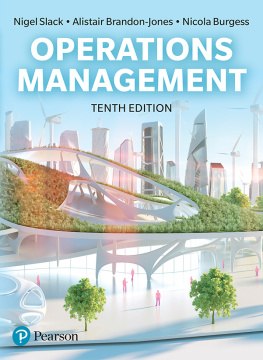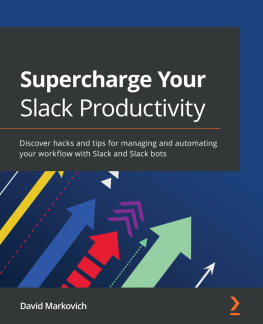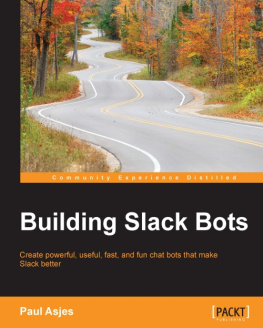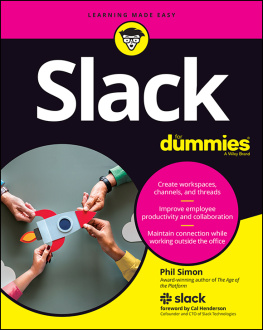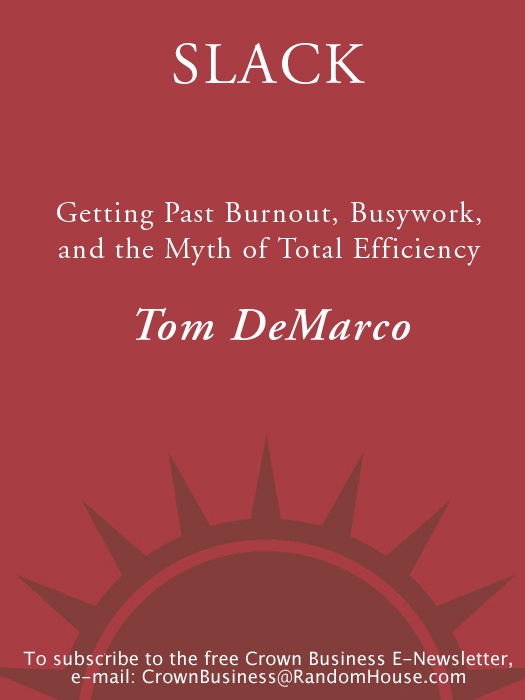Also by Tom DeMarco
Peopleware
The Deadline
Dark Harbor House
Why Does Software Cost So Much?
Controlling Software Projects
Concise Notes on Software Engineering
Structured Analysis and System Specification

SLACK . Copyright 2001 by Tom DeMarco. All rights reserved. No part of this book may be reproduced or transmitted in any form or by any means, electronic or mechanical, including photocopying, recording, or by any information storage and retrieval system, without written permission from the publisher. For information, address Broadway Books, a division of Random House, Inc., 1540 Broadway, New York, NY 10036.
BROADWAY BOOKS and its logo, a letter B bisected on the diagonal, are trademarks of Broadway Books, a division of Random House, Inc.
Visit our website at www.broadwaybooks.com
Library of Congress Cataloging-in-Publication Data
DeMarco, Tom.
Slack : getting past burnout, busywork, and the myth of total efficiency /
Tom DeMarco.
p. cm.
1. Industrial management. 2. Job stress. 3. Risk management. I. Title.
HD31.D4222 2001
658dc21
00-065109
eISBN: 978-0-7679-0899-3
v3.1
In memory of
Murray Ogden Smyth (19042000)
Acknowledgments
Thanks to my editor, Suzanne Oaks, and editorial assistant, Claire Johnson, at Broadway Books for help in preparing Slack for publication. I particularly value the patient guidance they offered about changes required for the work to be able to fulfill its promise. Thanks as well to my agents Emma Parry and Michael Carlisle of Carlisle and Company for help in finding the perfect publisher.
The ideas and philosophies that make up Slack did not come to me out of a vacuum. They were formed and tested over years of interaction with clients and coworkers. Thanks to all of them. For specific insights and (just as important) useful ways to articulate them, I owe a special debt to my colleagues at the Atlantic Systems Guild: Peter Hruschka, Steve McMenamin, John Palmer, James Robertson, and Suzanne Robertson. Each has contributed at least one thing to the book. I am particularly indebted to Tim Lister, who, over the course of nearly twenty-five years of close interaction, has helped to shape my thinking on most aspects of organizational life. (He has sometimes made me go, Ahah! so hard it hurt my chest.) Thanks as well to Rob Austin, James Bach, Sheila Brady, Karen Coburn, Allan DeMarco, Ernst Denert, Lesley DeVoe, Rose Ann Giordano, Jim Highsmith, Norm Kerth, Jut Kodner, Ken Orr, Sally O. Smyth, Bruce Taylor, John Taylor, Jerry Weinberg, and Ed Yourdon for ideas and phrasings and nuances that made their way into the pages of Slack.
Tom DeMarco
Contents
10. A Little Sleight of Hand
in the Accounting Department
Prelude
Slack is a prescription for building a capacity to change into the modern enterprise. It looks into the heart of the efficiency-flexibility quandary: The more efficient you get, the harder it is to change. The book shows managers how to make their organizations slightly less efficient but enormously more effective. It coaches them on the introduction of slack, the missing ingredient required for all change. It counsels a thoughtful use of slack instead of the mindless obsession with elimination of all slack in the interests of efficiency.
Why Now?
We live in an age of acceleration. Whatever the formula was for business success a few years ago, it wont work today. Today there needs to be more and more work crammed into less and less time. There are fewer people doing more and doing it faster in less space with less support and with tighter tolerances and higher quality requirements than ever before. The average manager or knowledge worker is so busy today that there is simply not a spare moment for anything. There isnt time to plan, only to do. There is no time for analysis, invention, training, strategic thinking, contemplation, or lunch.
Only a decade ago, the workplace was characterized by bankers hours, conversations around a water cooler, extended business meals, early closings in summer, and the corporate softball league. Today such things have gone the way of the milkman and the full-service gas station.
The ubiquitous Hurry Up mantra of business today has undoubtedly helped corporations speed up. They do what they do faster and more cheaply than before. But there is a downside
Enter the Need for Change
Suppose that what the corporation is doing now has to be changed. The needed change is not just to do the same things still faster but to switch directions and do something else entirely. Change is always complicated and challenging, but in the superaccelerated corporation, change of direction is almost impossible. The very improvements that the Hurry Up organization has made to go faster and cheaper have undermined its capacity to make any other kind of change.
An organization that can accelerate but not change direction is like a car that can speed up but not steer. In the short run, it makes lots of progress in whatever direction it happened to be going. In the long run, its just another road wreck.
Plan of the Book
The book is divided into four parts, each with its own mini-theme:
| Part One | Slack: The unfortunate tradeoff between efficiency and flexibility. How organizations tend to get more efficient only by sacrificing their ability to change. How slack can come to the rescue. |
| Part Two | The effect of stress on organizations: It leads them badly off course while causing them to redouble their speed. Causes of and cures for corporate stress. |
| Part Three | Change, growth, and organizational learning: The difference between companies that can learn (and profit from their learning), and those that cant. |
| Part Four | Risk taking and risk management: Why running away from risk is a no-win strategy, and why running toward it makes sense when managed sensibly (and what that entails). |
Slack is directed toward management at all levels in knowledge organizations and other modern corporations where knowledge workers predominate. It is also directed to the knowledge workers themselves. Its directed toward you if you sense that there is something terribly wrong in the infernal busyness of the modern workplace, if you know in your heart that the slack that has been squeezed out of your organizations over the last ten years now has to be reintroduced, or no further meaningful progress will ever be possible.
The fact that youve decided to read this book says that you are busy. You havent got time for an extended treatise on organizational forms or a theory of management. At most, you may have the time for a very fast, very pointed airplane read. I have put this book together so it can be read cover-to-cover on a flight from New York to Chicago or from Amsterdam to Rome. It is my hope and expectation that after reading it, you can step off your flight with a straightforward approach for helping your organization make the kinds of change it will need to make in order to survive.


